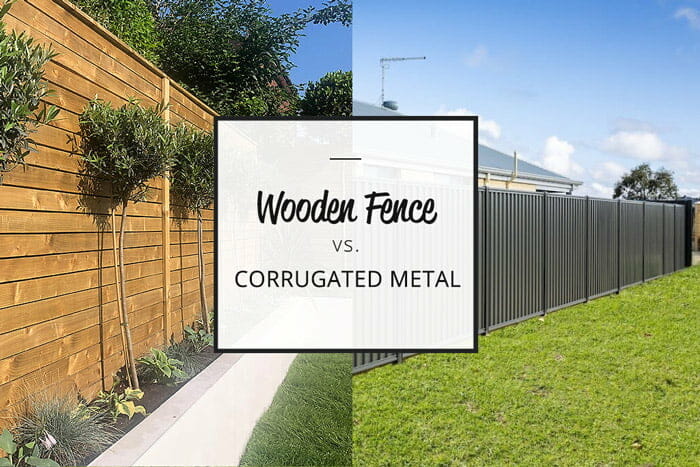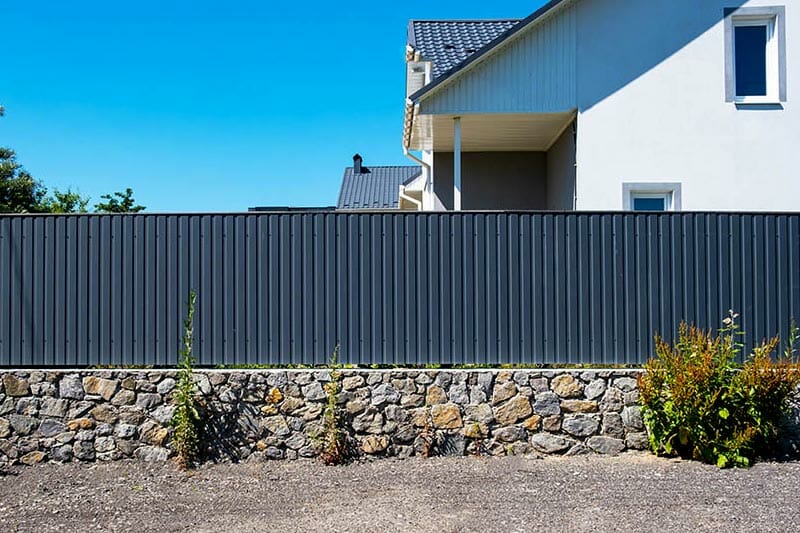Acquiring a property equipped with a fence may not appear significant, particularly if the existing fence is functioning properly. However, when it involves constructing a new home or replacing an outdated fence, selecting the appropriate style is crucial.
The purpose of the fence is primary; aesthetics, security and providing privacy. Corrugated metal is an excellent choice for building a fence, but so is wood. If you are torn between the two materials, this article is a comparison to help you make an informed choice.

Comparison Between Corrugated Metal Fence and Wood Fence
The following are crucial points when comparing a corrugated metal fence and a wood fence:
Installation
Corrugated metal may be difficult to install if you are DIYer. For trained hands, it may not be so much work, but if you are using a professional, it means you have to pay for the services. The metal can also be dangerous; wrongly handling it may cause severe injuries. This is true even if there are pre-assembled options for fences.
Wood, on the other hand, is simpler and easier to install than corrugated metal. You can even follow instructions to do the installation yourself as a DIYer if necessary. This depends on the fence’s size and weight; you may need extra hands for the job. However, note that wood tends to shrink slightly after installing it, and it can create unwanted gaps in the fence.
Performance
Corrugated metal sheets perform better than wood. If you use corrugated metal sheets for your fence, you do not have to worry about deterioration or rot if you use corrugated metal sheets for your fence. Also, there is no danger of termites or other pests eating them, and they do not warp.
Corrugated metal is stronger than wood and can withstand more pressure if necessary. It will take years before you have to replace a fence made of corrugated metal; it can last up to 40 years.
A wood fence is not a great performer when it comes to rot and deterioration. It quickly gives in to moisture and wears out easily, especially with a lack of maintenance. It is also prone to warping when there are extreme weather changes.
While it may last years with excellent care, it may eventually give in to moisture absorption, termite infestation, and extreme warping. Treated timber may be an ideal option for a fence.
Aesthetics
There are various aspects of aesthetics to consider. One is how much the material allows you to design it. Two are the customization options, and three are staining and painting.
Corrugated metal is restrictive in the aspect of design. Yes, you can get creative with paint colors and drawing designs, but you can only do so much, especially if the property is commercial. Also, you are limited in your customization options with metal. For example, you cannot trim the fence if it becomes higher than desired.
The options are endless for wood when it comes to aesthetics. In fact, many property owners prefer wood because of its flexibility. You can always trim, change the design, customize, and do a variety of other things to a wood fence. Staining or painting it may even reduce the potential damage from UV rays due to extended exposure.
Eco-friendliness
Corrugated metal is not as easily disposable as wood. Correctly disposing of metal may mean taking it to a recycling plant, which may not always be convenient, especially if there are many sheets to discard. The fence may even pose a danger if the metal is damaged with uncovered and sharp edges.
Wood performs better in this aspect. Although it is more prone to rotting and damage, there are ways to ensure it lasts longer. Moreover, it is easier to dispose of it without necessarily needing a recycling plant or causing harm to the environment.
Maintenance
In terms of maintenance, corrugated metal fences are better than wood fences. Corrugated metal needs only minimal attention while giving optimum performance. Due to its lack of staining or painting, there is typically no need to refinish it every couple of years. Besides, you can find options that do not easily give in to rust due to a powder coating.
Wood needs more time and effort to maintain. A lack of attention may cause it to deteriorate quickly; you will need to service it regularly to keep it in top shape. Staining and painting mean you have to sand, prime, and refinish the wood every couple of years, which is tedious. This is especially true if there is a large area to handle.
Benefits of using a corrugated metal fence
Several benefits accrue to using corrugated metal to build a fence around your property. Let us take a look at some of them:

Long lifespan
Corrugated metal typically has a long lifespan, between 25 and 75 years. If you choose to use an entry-level type of this metal for fencing, you may get up to 30 years, depending on usage and maintenance.
This type is not thick, so it may not withstand the rigors of the elements. Options with medium thickness can last between 30 and 40 years, while those with maximum thickness can last up to 75 years.
Minimal maintenance
As explained before, a corrugated metal fence does not need as much attention as a wooden fence. You will not have to stain or paint or even apply a water-resistant sealant to prevent moisture penetration. The landscape where you may want to use the metal sheets may be sloppy, which reduces the work needed to prepare for installation.
Ideal investment
Since there is not much in the way of maintenance and the sheets tend to last for decades, it is an investment to use corrugated metal for your fencing needs. Some materials come prepared to withstand rusting and other possible issues. So, you may even get more use out of them if you remove them as a fence. Besides, there are recyclable corrugated metal sheets to divert to other uses in the future.
Excellent water runoff
Corrugated metal is one with a rippled look, with the metal appearing to have waves. The rippled look, called ridges, makes this metal excellent at encouraging water runoff. If it rains, the water does not collect on or around the area, preventing the framing material from rotting, especially if it is wood.
It is extra work having to replace the fence frame because of deterioration; you want to have material that lasts as long as the metal sheets or close to them. Pressure-treated timber is ideal for this purpose.
Benefits of using a wood fence
Using a wood fence also has its benefits, as explained below:

Flexibility
With a wood fence, you can get creative. Different types of paint work on wood and give it a new look each time you repaint. You can even mix colors without making the fence appear tawdry. Also, the material gives room for easy shortening if necessary. And some available accessories go well with wood fences to give the yard a new look.
There are different styles to choose from; you can go for rustic or stick with a sophisticated design. The choice is yours, but you must consider the environment and what suits it. A wood fence can provide privacy without making the property appear like a fortress.
Ease of installation
Another benefit of using a wood fence is the installation. Unlike corrugated metal, where you may require the help of a professional, you can install a wood fence yourself if you have the time, tools, and help you need.
With corrugated metal, there are sharp edges to worry about, but the same is not the case with wood. Moreover, it is quick to install, so you can begin using it as quickly as possible.
Versatility
A wood fence works well with any environment or area. You can install it in the suburbs, city, or even on a farm. Different establishments such as schools and government offices can use it. Similarly, it fits in with any type of residential property, whether an apartment complex or a personal house.
Accessible
Finding the best type of wood for your fencing needs is not difficult. You may need expert advice, but there are several options on the market. Also, wood fence materials are usually affordable, even the treated timber. Let your environment and usage inform your choice, but treated options are usually the best.
Cost factors to consider when building a fence
Certain factors play a significant role when building a fence, whether you are constructing a new one or replacing an old one.
- Installation method. If you are doing the job yourself, consider your skill set. Some materials, such as metal, need expert hands, and if you do not have the training, it means additional costs because you will need to hire professionals for the job.
- Material type. The type of material you wish to use will determine how much money you will spend on your project. Corrugated metal and wood fences do not have a large cost variation, but the actual cost will depend on the type and grade of the material.
- Fence type. The type of fence you want will also determine the overall cost of the project. For instance, a privacy fence would cost more to install than a simple picket fence.







